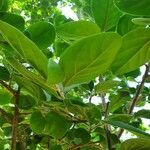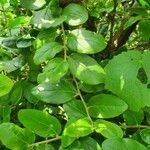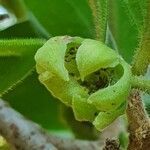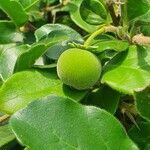Shrub or tree, much branched, up to 8 m. tall; trunk up to 20 cm. across, with pale greyish-brownish bark.. Branchlets sometimes with rather slender axillary spines 0.5–1.5(rarely –2.5) cm. long.. Leaf-blades ovate-oblong or-elliptic, apex gradually obtusely attenuate, or sometimes rounded, base broadly attenuate to obtuse, thinly to more firmly chartaceous, sparsely and very shortly pubescent on the nerves beneath, glabrescent, entire to repand-crenate or subserrate, (3–)4–9 cm. long, 2–3.5(–4.5) cm. broad; lateral nerves 4–5(–7) curved-ascending pairs, slightly raised beneath, reddish in fresh specimens, no proper reticulation; petiole 2–4(–5) mm. long.. Male flowers 1–3 in a fascicle in generally already defoliate axils, rusty-puberulous or tomentellous all over; pedicels 5–8(–13) mm. long.. Calyx-lobes (4–)5(rarely 8), subovate-oblong, subacuminate, 5–6 mm. long, 2–3 mm. broad.. Stamens 40–60.. Interstaminal glands hairy apically.. Female flowers solitary or rarely in pairs in defoliate axils; pedicels stoutish, 6–8 mm. long.. Calyx-lobes similar to, though slightly larger than those in the male flowers.. Disk annular, crenulate, finely hairy.. Ovary rusty-puberulous to-velutinous; styles 4–5(rarely 6).. Fruit globular, yellowish-reddish with minute paler dots, papillose-puberulous or glabrescent towards maturity, ± 2 cm. across.. Seeds few, appressed hairy.. Fig. 21/1–9.
More
A medium sized shrub. It grows up to 10 m tall. It has many branches. The trunk is up to 20 cm thick. Young branches can have spines. The bark is grey brown. There are many raised lenticels. The leaves are oval and slender. They are 2.5-9 cm long by 2-5 cm wide. The edges of the leaves can be wavy or jagged. Plants are separately male and female. Flowers are green. Male flowers are covered in soft hairs. They are in clusters in the axils of leaves. Female flowers occur singly. The fruit are small and orange. They are round and have pale dots. They are up to 2 cm across. The flesh is yellow. They are very acid and have a strong smell. The seeds are few and flat.
A natural hybrid between Diospyros abyssinica x Dovyalis hebecarpa. A large spreading shrub. It grows 7 m high. The branches are long and drooping. It has few thorns. The leaves are deep green and densely grouped together. They are 7.5-10 cm long. The flowers are greenish-yellow. They are small and have no petals. The male flowers have long yellow stamens. The fruit are round and 3 cm across. The flesh is yellow-orange to deep red.







